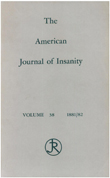Increasing incidence of anorexia nervosa in the female population of northeast Scotland
Abstract
OBJECTIVE: The aim of the study was to determine whether there has been an increase in the incidence of anorexia nervosa in the female population in the northeast of Scotland since the 1960s. METHOD: Standardized diagnostic criteria were applied to the case records of female subjects who had been diagnosed as suffering from anorexia nervosa and had presented for the first time to psychiatric services between 1965 and 1991 or had been admitted for the first time to a general hospital between 1970 and 1991. Age-standardized annual incidence rates were calculated from 1965 through 1991. As a broad measure of severity, the weights of patients in 3 early years of the study, 1970-1972, were compared with those of patients in the last 3 years, 1989-1991. RESULTS: Over the 27-year period studied, 287 patients received confirmed diagnoses of anorexia nervosa, and the mean annual increase in incidence was 5.3%. The rate of increase was highly statistically significant. Comparison of weights at presentation showed a trend for patients presenting in 1970-1972 to be lighter than those presenting in 1989-1991. CONCLUSIONS: Rates of referral for female subjects with anorexia nervosa have greatly increased since the 1960s. These rates likely reflect a genuine increase in incidence, but the data suggest that less severely ill patients are now being referred.
Access content
To read the fulltext, please use one of the options below to sign in or purchase access.- Personal login
- Institutional Login
- Sign in via OpenAthens
- Register for access
-
Please login/register if you wish to pair your device and check access availability.
Not a subscriber?
PsychiatryOnline subscription options offer access to the DSM-5 library, books, journals, CME, and patient resources. This all-in-one virtual library provides psychiatrists and mental health professionals with key resources for diagnosis, treatment, research, and professional development.
Need more help? PsychiatryOnline Customer Service may be reached by emailing [email protected] or by calling 800-368-5777 (in the U.S.) or 703-907-7322 (outside the U.S.).



